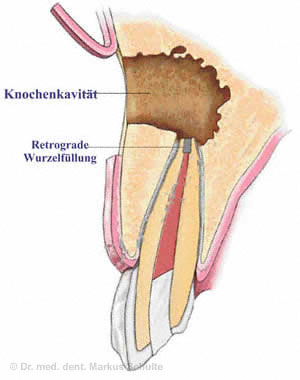Apicoectomy (Root Resection)
Root resection (RR) or Apicoectomy is a surgical procedure to remove the tip of a tooth's root. RR is usually performed on root canal-treated teeth when the root canal treatment has failed. In such cases, an inflammation (granuloma) or cyst often forms at the root tip, which dissolves the bone and can cause pain, a fistula (an external outlet) or an abscess (pus-filled bump). RR may also be necessary to remove foreign bodies (e.g. root filling material pushed out through the root tip) or broken root canal instruments in the root tip area. With advances in endodontics (root canal treatment), the success rate of root canal treatments is much higher today than in the past. For this reason, root resections are no longer performed so frequently.
Root Resection - the procedure

Root resection is a routine procedure in our practice, usually performed on an outpatient basis under local anesthesia. For anxious patients, nitrous oxide analgesia or sedation with tranquilizers may also be used. A gum incision is made to expose and remove the bone covering the root tip until the root tip is exposed. This is then cut off (resected) and removed along with the inflammatory tissue. Ultrasound-powered minimally invasive instruments are used to prepare and widen the root canal (or canals in multi-rooted teeth) from the cut surface and then sealed with a special cement (retrograde root filling). Larger bone defects, e.g. cysts, can be filled with bone substitute material. The wound edges are then tightly sutured.
Root resection should be considered as a last resort to preserve a tooth after failed root canal treatment. The procedure is successful in the long term in 60-90% of cases (depending on the condition of the root canals and anatomical location of the root tip). As an alternative, extraction of the tooth and its replacement with an implant may be considered.

